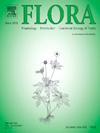Ontogeny has a greater effect on defense and leaf nutritional status than fertilization in Stryphnodendron adstringens (Fabaceae)
IF 1.7
4区 生物学
Q3 ECOLOGY
引用次数: 0
Abstract
Investment of plants in defensive and leaf nutritional quality traits may vary with plant ontogeny and the availability of soil nutrients. In this study, we evaluated the effect of ontogeny and soil fertilization on leaf traits of the Brazilian cerrado tree Stryphnodendron adstringens (Fabaceae). Leaf defense traits (total phenolics, condensed and hydrolysable tannins, the number of extrafloral nectaries (EFNs) and the concentration of glucose, sucrose, fructose and total sugar in the extrafloral nectar) and leaf nutritional quality traits (water content, macronutrients, micronutrients and N:P and C:N ratios) were measured in 60 seedlings and 13 reproductive adults that grew in areas with previous P and Ca fertilization over eight years and in neighboring control plots in a Cerrado area in Distrito Federal, Brazil. Sampling was carried out three years after the last application of fertilizer. We found a strong effect of ontogeny on leaf traits: leaves of adult plants were more chemically defended and lower in nutritional quality than those of seedlings. Fertilization modified leaf nutritional quality traits in adults and seedlings, and defense traits in seedlings, increasing the number of EFNs on leaves, total phenolics and condensed tannins. In summary, adult plants of S. adstringens were poor in nutrients and invested more in phenolics and tannins than seedlings, all consistent with plant apparency theory. In contrast, seedlings were much more flexible in their defensive phenotype, with fertilization increasing allocation to total phenolics, condensed tannins and EFN production. This latter result suggests an ability of seedlings to take advantage of very local variation in resources that might increase the likelihood of surviving this vulnerable stage in the life cycle.
与施肥相比,本体对 Stryphnodendron adstringens(豆科)的防御和叶片营养状况的影响更大
植物对防御性和叶片营养质量性状的投资可能会随着植物的生长期和土壤养分的供应情况而变化。在这项研究中,我们评估了生长发育和土壤施肥对巴西热带雨林树木 Stryphnodendron adstringens(豆科)叶片性状的影响。叶片防御性状(总酚、缩合单宁酸和可水解单宁酸、花外蜜腺(EFN)的数量以及花外蜜腺中葡萄糖、蔗糖、果糖和总糖的浓度)和叶片营养质量性状(含水量、宏量营养元素、微量营养元素以及氮、磷、钾和 C:N 比率):在巴西联邦区的塞拉多地区,对生长在曾施过 P 肥和 Ca 肥地区的 60 株幼苗和 13 株生殖成株进行了长达八年的测量,并对邻近的对照地块进行了测量。取样是在最后一次施肥三年后进行的。我们发现,叶片性状受生长期的影响很大:成年植株的叶片比幼苗的叶片化学防御能力更强,营养质量更低。施肥改变了成株和幼苗的叶片营养质量性状,也改变了幼苗的防御性状,增加了叶片上 EFNs 的数量、总酚类和缩合单宁。相比之下,幼苗的防御表型要灵活得多,施肥会增加总酚类物质、缩合单宁和 EFN 生产的分配。后一种结果表明,幼苗有能力利用资源的局部变化,从而增加在生命周期中这一脆弱阶段存活下来的可能性。
本文章由计算机程序翻译,如有差异,请以英文原文为准。
求助全文
约1分钟内获得全文
求助全文
来源期刊

Flora
生物-植物科学
CiteScore
3.30
自引率
10.50%
发文量
130
审稿时长
54 days
期刊介绍:
FLORA publishes original contributions and review articles on plant structure (morphology and anatomy), plant distribution (incl. phylogeography) and plant functional ecology (ecophysiology, population ecology and population genetics, organismic interactions, community ecology, ecosystem ecology). Manuscripts (both original and review articles) on a single topic can be compiled in Special Issues, for which suggestions are welcome.
FLORA, the scientific botanical journal with the longest uninterrupted publication sequence (since 1818), considers manuscripts in the above areas which appeal a broad scientific and international readership. Manuscripts focused on floristics and vegetation science will only be considered if they exceed the pure descriptive approach and have relevance for interpreting plant morphology, distribution or ecology. Manuscripts whose content is restricted to purely systematic and nomenclature matters, to geobotanical aspects of only local interest, to pure applications in agri-, horti- or silviculture and pharmacology, and experimental studies dealing exclusively with investigations at the cellular and subcellular level will not be accepted. Manuscripts dealing with comparative and evolutionary aspects of morphology, anatomy and development are welcome.
 求助内容:
求助内容: 应助结果提醒方式:
应助结果提醒方式:


